Art Saul: ‘I Wanted to Do More’
Volunteer from Atlanta found a way to use his abilities to help Israel.
Chana Shapiro is an educator, writer, editor and illustrator whose work has appeared in journals, newspapers and magazines. She is a regular contributor to the AJT.
“Thankfully, we Jews immediately reached for our wallets after the horror of Oct. 7,” Art Saul, a 72-year-old retired actuary, says, “But I wanted to do more.”
Saul, who likes to take challenging hikes, run, and exercise, learned that seasonal workers from other countries who worked on Israeli farms had returned home at the start of the war (many had been taken hostage and released), thereby leaving Israeli farms at risk of losing their crops. Volunteering in Israel would become the next chapter of Saul’s Jewish story.
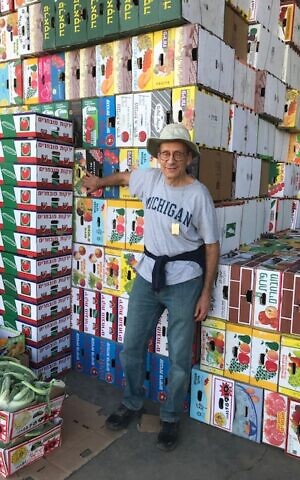
Saul grew up in New York’s Peter Cooper Village, in a family who belonged to a German American Reform temple. In those years, the Reform movement did not celebrate bar mitzvahs, and, instead of becoming a bar mitzvah, Saul was part of a confirmation class in his teens. His family did not have a JNF “blue box,” the ubiquitous receptacle in thousands of Jewish households to collect money for the nascent Jewish State, or observe Shabbat in any way, and they didn’t seem particularly concerned with Jewish issues or ideas.
When he was young, Saul read Leon Uris’ “Mila 13” about the Warsaw Ghetto heroic uprising, and, as he read more books with Jewish content, he wondered, “Are these Jews my people? Are Jews my brothers and sisters?”
He continued to learn about Jewish ethics, which he admired, and even visited Israel a few times with his wife, Robin, but did not deeply identify with the people.
Then, this past October, he learned about the murder of Atlantan Rose Lubin and was impressed by the sincere praise he heard about her from people who knew her.
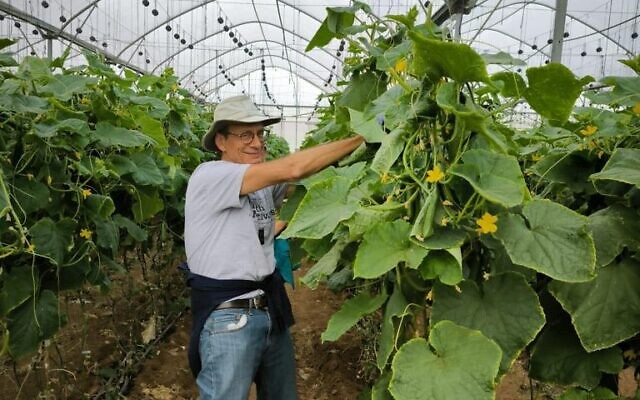
In Atlanta, he awoke in the middle of the night to hear Rose’s mother, in Israel at her daughter’s memorial service, read Rose’s bat mitzvah d’var Torah. He was so moved by the compelling words of a 12-year-old girl (who grew up to become a lone soldier and was tragically murdered while serving as a border police officer,) Saul was determined to go to Israel and “be useful. I couldn’t do nothing.”
Saul believed that he could handle some of the work the foreign laborers had left undone on Israeli farms, and he searched for a group in which he could volunteer, and which would meet three personal requirements: work outdoors, do physical labor, and address immediate, crucial Israeli needs. He found an international group that met his objectives, Israeli Food Rescue (IFR), which falls under the aegis of Israel’s Ministry of Agriculture. The cadre of volunteer workers Saul joined was comprised of Jews and non-Jews, men and women, of ages ranging from 30 to 82, from Russia, Canada, Australia, Hong Kong, Luxemburg, and the United States.
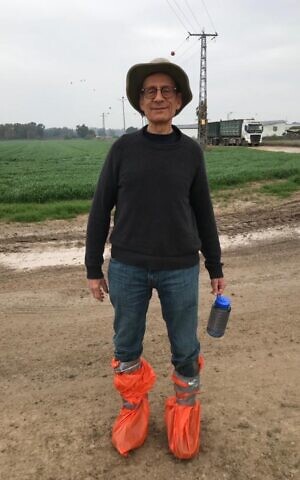
The group was housed in a “one-to-two star” hotel in Jerusalem. Before Saul planned his trip, he was cautioned, “Don’t go to Israel without a reserved bed.” Hotel rooms are currently so scarce in Israel because thousands of Israelis, who lived in areas considered unsafe because of the war, had to leave their homes and are currently being housed in all available hotel rooms.
The group had a bountiful Israeli-style breakfast early each morning, and at 7:00 a.m., boarded a bus that traveled an hour and a half each day to farms where crops needed to be planted. The bus driver, their unofficial leader, had been a tour guide who had no work because of the lack of current tourism in Israel. The orientation instructed the volunteers how to respond in case of a rocket attack because the farms had no “safe rooms.” They learned to lie face down and cover their heads with their hands. Fortunately, during Saul’s stay no sirens went off in his area.
At two farms near Ashdod in the Southern District of Israel, Givati and Ozer, Saul and other IFR workers followed a hired-hand schedule, planting fennel all day, with an on-site lunch break, returning to the Jerusalem hotel in late afternoon. Evenings and Shabbat were free (Sunday is a workday), and Saul was able to spend time with friends who live full or part-time in Israel.
The IFR volunteers worked in fennel bogs, on their hands and knees, learning the ropes from earlier volunteers in the program, working faster and more efficiently each day.
“It was planting season, so we knew our timing was crucial,” Saul explains.
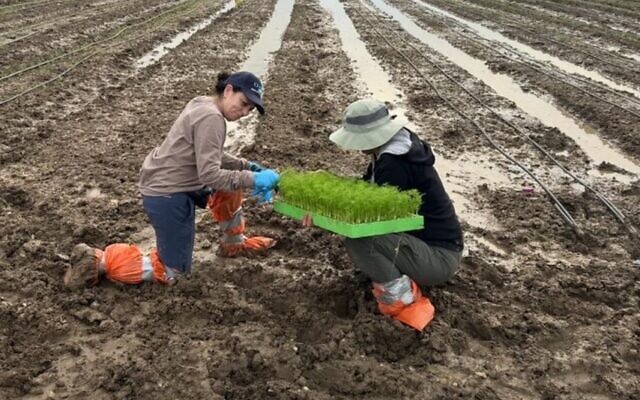
A potential setback occurred. Saul’s luggage had been misrouted, and the boots he brought along in anticipation of muddy agricultural assignments left him on the first day of work with only the running shoes he was wearing. Necessity is the mother of invention: Sturdy red, plastic bags were taped to cover his shoes. His luggage arrived the next day.
In a single day, Saul planted 18,000 plants, which were the contents of 300 trays. On an especially wet and muddy day, the volunteers were assigned indoors to assemble the large boxes in which produce leaves the farms, a job which required two individuals working on opposite sides of the box to complete each container, an exercise in cooperation and strategic creativity. Saul found that the task was more complicated than the large, finished product appeared. Nevertheless, 5,400 boxes were completed!
One morning, a man from nearby Moshav Meshek Saisel drove by on a tractor as the group toiled. He was surprised to find volunteers hard at work planting. He invited them to tour his dairy moshav, which also grew vegetables. The group ended up spending a day harvesting tomatoes and cucumbers in the huge commercial greenhouse. While there, Saul befriended a coterie of Africans who were on a six-month exchange program in Israel to learn adaptable agricultural techniques they will take back to their native countries. These exchange students live on the moshav and were already adept at managing the greenhouse tasks. (Israel has a similar program with Cambodian agriculture students.) After the day working at Meshek Saisal, in which Saul enjoyed interacting with the Africans, the fennel group returned to their work in the farm bogs.
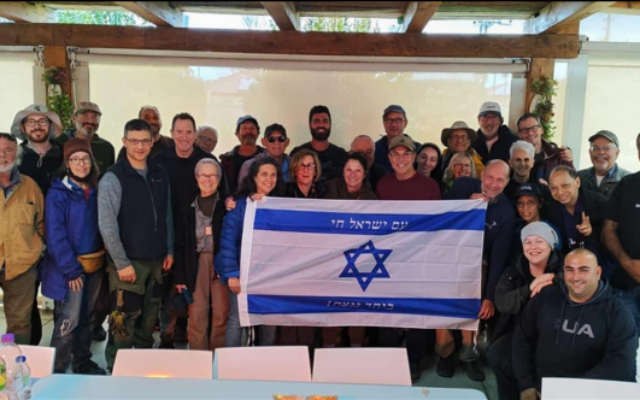
Saul’s pre-trip research had revealed other possible work trips; however, the one he chose was more affordable than most and included Shabbat meals. Israel Food Rescue is an ongoing endeavor in which participants continuously come and leave.
Saul was the only “newbie” on the day he arrived, and his brief self-introduction to the group was balanced by others who were bidding farewell. Instant camaraderie was a major benefit for the diverse people who spent a lot of time together, especially on the long bus rides to and from work.
Volunteers pay their own way to cover air fare, food, and housing. Saul’s 10-day trip cost $1,000, in addition to airfare. Saul muses about his adventure, “This trip was meaningful in many ways: helping the people and country of Israel by working in an economic sector dependent on manual labor, a chance to visit with friends, and the opportunity to connect with other Jews, regardless of where they call home.”



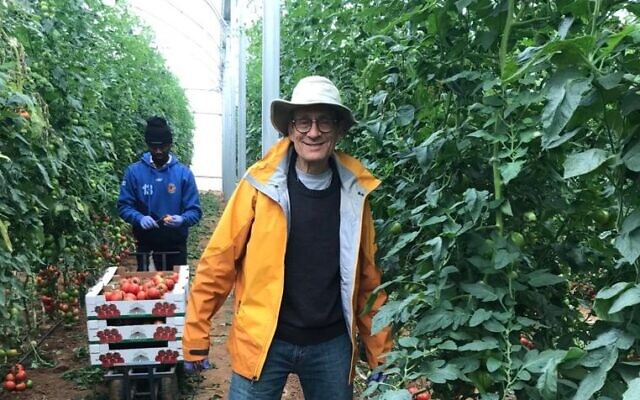
comments